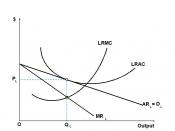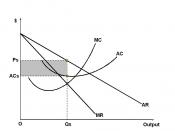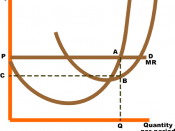The market structure is defined by the number of firms in the market, the persistence of barriers to the new entry of companies, and the interaction with other firms in pricing decision and the outputs toward maximizing profits. The simulation comes across the four types of market structure within the East-West Transportation Company. Consumer Goods, Coal, Chemical and Forest Products are the four divisions that operate within the four market structures (UOP, 2009). This paper will focus on the advantages and limitations of supply and demand identified in the simulation, the effectiveness of market structures for Staples Company, and how organizations can maximize profits in each of those market structures.
Advantages and Limitations of supply and demandFirst, a decision has to be made whether to maintain or shutdown operations. Continuing with operations in highly recommended in the perfect competition market. In the first scenario the market demand curve is downward sloping, the sellers recognized the individual demand curve facing them to be perfectly elastic at a specific price.
With such demand curve and the cost structures in such a scenario, producing and outputting at maximized profit were attempted by sellers.
As stated by Tanya Roy, the law of demand restrains in a monopoly. The coal division operates in the monopoly structure where the demanded quantity is still high even though the price is high and therefore, profit does not need to be high (UOP, 2009). The demand curve is noticeably downward sloping in the monopolist structure. The price could be also higher than marginal revenue; but in the case of output where Marginal Revenue equals Marginal Cost, quantity line to the demand curve could be extended in order to decide on the price that needs to be charged for such an output.
Oligopoly- duopoly in the Chemical Division is the...



Well done
its quite obvious that you did your homework on this one. good job.
0 out of 0 people found this comment useful.